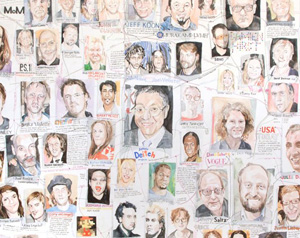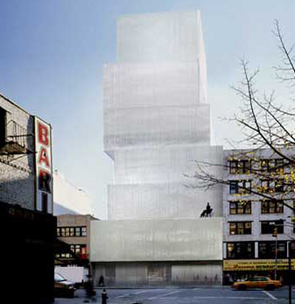What Alternative Art?
John Haberin New York City
Alternative Spaces and Alternative Histories
Is there no alternative? Artists everywhere are demanding one.
No alternative
They are demanding one right in their studios, on Facebook, and through their Web sites. They do it in collectives and self-curated shows, in a dozen competing art fairs, and in the "Brucennial" from the Bruce High Quality Foundation that squared off against the Whitney Biennial. They vent their anger and scorn on panels—like one on "The Handmade" that included me. They make their demand into exhibitions, like William Powhida and Jennifer Dalton, who turned a gallery into a class on the art world. Ironically, they are also putting the very idea of an alternative space into question. What once was an imperative, to stand up for a new vision of art, may well be losing its imperative and its vision. 
Some who all but disdain having a business sense are starting their own galleries deeper and deeper into Brooklyn. As I write, open studios in Greenpoint compete for attention with the Unaffordable Art Fair. Where once the public had a monopoly on distrust of the latest art, now it extends to artists. Somehow the walls are getting higher and higher. Yet it is also getting harder and harder to distinguish the insiders. Maybe it is time to remember when one could.
Exit Art believes in alternatives. After all, it created one, thanks to Jeanette Ingberman and Papo Colo almost thirty years ago. Its present location alone, near the Holland Tunnel, insists on one—a space for art between Chelsea and the middle of nowhere. Now it shows that alternatives have a history, while art's history since the 1960s was less a straight line than dozens of alternatives. "Alternative Histories" documents that period through the fate of well over a hundred alternative art spaces and projects, although none of their art. Each gets its place on a time line, a one-page history, perhaps a poster or two, and a box for scraps of its past.
The flat, cardboard-brown boxes lie stacked and scattered on a long table stretching the length of the gallery. One can find the name of an alternative space in plain block letters and put on gloves to examine the box contents. Black curtains to either side emphasize the paradox of breadth and near anonymity. The time line and posters lurk behind one curtain—an exhibition of alternatives as history. The café has taken on a little extra alternative space for the occasion behind the other. Watching people opening boxes, I could imagine either a pizza party or a police investigation.
Maybe that, too, is part of the paradox of an alternative space, caught between bringing people together and taking a stand. Most projects wanted both, going back at least to 1961, when Claes Oldenburg opened his "Store" on East 2nd Street. Almost all incorporated politics, feminism, and diversity into exhibitions, back when mainstream galleries largely preferred formalism, irony, or expression. At the same time, one can divide them roughly into two camps, one for each horn of the dilemma. Those like ABC No Rio on the Lower East Side, Triple Candie in Harlem, or Fashion Moda in the Bronx sought to return art to their communities. Those like SculptureCenter, the Kitchen, or Exit Art itself aspired to something more like an alternative museum.
One can see it as the choice between turning against late Modernism or sticking up for the avant-garde, just when Soho and then Chelsea were busy co-opting both. Maybe that is why the old alternatives are losing their meaning for too many artists. It is not that the insiders exclude them. It is that the art world grew in size, scope, and wealth to encompass almost everything, with celebrity installations just one stale alternative among many. No wonder the handful of recent entries at Exit Art amount to neither alternative, but rather to Brooklyn nonprofits taking much the form of traditional galleries. And increasingly, it becomes harder to tell galleries, museums, and alternative spaces apart.
Annals of money
Among those on display, the New Museum now has its director from an auction house and its shiny box on the Bowery, and P.S. 1 is absorbed into MoMA. These are disasters not just for their status as alternative spaces, but for contemporary art. In one of this site's very first reviews, I took the Staten Island ferry to visit Snug Harbor, where abstract artists insisted: painting was not dead. Only a spoil sport would object that the cultural center lay a mile's walk from a residential center—in a borough whiter at the time than a Robert Ryman painting. Now painting is thriving along with everything else, but Snug Harbor as a venue for art is not.
Meanwhile, if the line between alternative spaces and galleries is blurring, so is the line between galleries and promotional opportunities. Take just another fall weekend in Chelsea. After Jennifer Steinkamp, Lehmann Maupin was showing what amounts to trailers for Tyler Perry's new movie, For Colored Girls, based on the play by Ntozake Shange. This coincides with the efforts of Lionsgate to "position" the film as "a work of art." That may or may not extend to the gallery's four-minute loops, shot by the marketing manager. The gallery Web site does not mention whether the "portraits" (as opposed to the space) are for sale.
 Art fairs, auction prices, the cost of Chelsea and Williamsburg real estate, the revolving door between dealers and curators or collectors and museums, overblown installations, and overblown reputations—you know the culprits. All these mean too many guardians with too much money. No wonder artists are angry. When they look at openings and MFA programs, they see business as usual. And they are pushing back. A show of alternative histories could not come at a better time.
Art fairs, auction prices, the cost of Chelsea and Williamsburg real estate, the revolving door between dealers and curators or collectors and museums, overblown installations, and overblown reputations—you know the culprits. All these mean too many guardians with too much money. No wonder artists are angry. When they look at openings and MFA programs, they see business as usual. And they are pushing back. A show of alternative histories could not come at a better time.
Yet too many collectives set up miles apart from one another, as well as apart from potential commercial development—with little publicity outside free Brooklyn weeklies and without even coordinating openings. They take small storefronts that might suit a risky installation like Oldenburg's decades ago, but instead pack in a group show, often of each other. They may end up not building alternatives, but insisting on their indifference. Loren J. Munk, the Brooklyn critic, does just that, too, when he slams critics for caving in. How, he asks, can Jerry Saltz object to the art market while praising dealers? What kind of hypocrite claims to stick up for art while getting it filtered through commercial spaces and fall openings?
Actually, Saltz is as willing as anyone to step out of closed circle. He sat quietly with me while the artists and critics in one event probed the art world—to confuse life further, in a commercial gallery. He goes to all sorts of places, he interacts with artists on Facebook and a reviewer Web site, and the quote at issue comes from a lecture outside New York circulated on YouTube. If fame has gone to his head, hey, blame the Web. And if there is a hypocrite here, it is Munk. He has an inflated importance because, as James Kalm, he tapes openings at commercial galleries.
Besides, how about a show of hands? How many artists think that market pressures and failures have gotten out of hand? Conversely, how many think their dealer cares about art and is dedicated to promoting it? And how many artists without a dealer want one? I thought so. Artists are part of the market, too, and one can get angry at the market without hating artists.
Lite or filtered?
Art needs alternatives, but can it still create them? Again it may take looking back. As "Alternative Histories" shows, an alternative space could rebel against business as usual either in the name of art alone or to connect art to the community. And again, as Max's Kansas City in the 1970s and El Teddy's in the 1980s showed all too well, a closed circle is not a community. Nonprofits can be real alternatives—and so can commercial dealers with integrity. But it will take learning from both models.
Artist collectives can play a valuable role, and when Marx dismissed primitive socialism, he probably did not have them in mind. Still, the fact is that everyone depends on filters, and great dealers or great alternative spaces are great filters. I appreciated Pace gallery's anniversary celebration this fall—as a reminder of what filters like Arne Glimcher, Paula Cooper, Leo Castelli, Ileana Sonnabend, Peggy Guggenheim, Heiner Friedrich, Marcia Tucker, Alanna Heiss, and others have meant to art in America, past and present. Wanting better filters is no stranger than wanting to regulate Wall Street after the latest market disaster. The poverty that drives out artists is a filter, too. A critic has both to express gratitude for those that survive and to make demands as well, and alternative spaces can, too.
Distrust alone can breed not true alternatives, but cynicism. Not every collective is an alternative. Conversely, not every erosion of the boundaries between inside and out is a loss. Tim Nye and Lia Gangitano, the founders of Thread Waxing, have moved on to splendid galleries, while the brief X-Initiative brought together some of the slickest but also best galleries in Chelsea. The Drawing Center came within a hair's breadth of being absorbed into Ground Zero before returning to Soho with WXY architecture. And the political attacks that barred the move had no love for the arts.
Yes, the definition of alternative art has grown more difficult, now that cash is short but the art world can encompass anything. And yes, it is harder to rebel and harder not to. Real estate is costly, but for most art is a luxury good. The market extends everywhere, but for most the boom is over. Should you lament or celebrate? Should you mourn or organize?
Just to ask shows that there is hope after all for dealers, nonprofits, and critics alike. The two kinds of alternative space back then had something very much in common, the fierce urgency of now. An artist collective or self-curated show today may not, but then again neither does art after Modernism and after the culture wars. I like to think that it still can, though, despite the obstacles. I like to think, too, that many artists, dealers, and nonprofits already do. With luck, Exit Art and "Alternative Histories" will awaken others to try.
Dealers should not have a monopoly, and alternative spaces can provide a challenge. But they can do so only by remembering the urgency that made them important in the past. I had to wonder who will benefit from "Alternative Histories." For those like me, who have climbed the face of the Clocktower and visited friends' studio at P.S. 122, it may feel like old news. For someone younger, faced with spare visuals and bare histories, it could be meaningless. One can only hope that some of those newer voices will find an alternative.

"Alternative Histories" ran at Exit Art through November 24, 2010, and Loren J. Munk complained on November 3. The clips at Lehmann Maupin ran through October 27. Portions of this review first appeared in Artillery magazine. A later note says farewell to Jeanette Ingberman of Exit Art.




